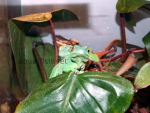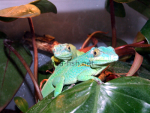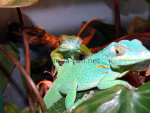Knight Anole (Anolis equestris) - Care and Pictures
Quick links
Brief Description
Although aqua-fish.net is devoted to fishkeeping, this page is dedicated to taking care of Knight Anole's as many aquarists keep other pets - not only fish. You're welcome to share your experiences with these creatures at the bottom of this page!
Anolis equestris are becoming a very popular pet in recent years but don’t expect them to be very user friendly as they are renowned for their low tolerance of handling levels and can deliver a nasty bite if allowed to. These are best kept by experienced keepers as they can be more demanding than other lizards with their special requirements but looking at them they are indeed well marked and display a good colouration which is pleasing to the eye.
Their common name is the Knight Anole or more often used is the Cuban Knight Anole which refers to their original habitat which is based in Cuba. In recent years they have been smuggled over to Florida which has resulted in a population being established there, this in turn has made the smuggling senseless so it is now on a down slide.
They are one of the larger of the Anole, adults can reach up to 19 inches in length and they do require a lot of space in their terrarium, at least 30 gallons is acceptable. Classification has placed them in the family of Polychrotidae, and in the order of Squamata, sub order Iguania. They have a long, narrow nose with a compressed tail that has a serrated edge along the top. They are excellent climbers as each toe has a pad that gives them excellent grip acting like a suction cup and they can even climb up walls that are completely vertical. Each toe also has a claw that aids with their branch climbing, these can also be used to defend themselves so if you are going to handle this lizard, always treat it with respect. Keeping more than one specimen together will also lead to problems as they are extremely aggressive towards each other when kept in a confined space, a single specimen is a lot easier to care for, especially as regards piece of mind.
Their general body colouration is a vivid green, this can change according to their mood, and they will display a yellow or white stripe on either sides of their head. This stripe runs from below each eye and carries right through to their shoulders. The skin of the Anole will feel slightly rough to the touch as its surface is uneven and covered in a pimply texture.
Caring for you Knight Anole
As mentioned above, these lizards grow quite large and do require ample room in the vivarium. Use at least a 30 gallon tank and this can then be furnished to suit their needs. Branches will need to be added as the Anole do like to climb and use a suitable substrate at the bottom. The temperature should be kept between 26°C - 32°C (80 - 90°F) and this can be reduced during the night hours by a few degrees. Do not allow the temperature to drop too low or the metabolism of the lizard will slow down and they will refuse to eat and enter a shut down mode.
The vivarium should allow lots of light in, some keepers use modified aquariums while other will invest in specially designed wooden vivariums with glass panels, the choice is yours but don’t choose shallow ones, the Anole needs to climb so the higher the space available the better.
They will require a basking lamp as UV light is very important, the lamp will need to be situated inside the vivarium and in such a position that the Anole is never more than one foot away from it while it is switched on. It should be left on for at least 10 hours per day minimum, some keepers prefer to keep them on even longer, up to 12 hours per day.
The heating can be achieved by a few different methods, heat mats can be placed underneath the vivarium but this is not always the most efficient and cost effective method. You can purchase thermostatically controlled heaters or spot lamps, once the desired heat setting is reached, they will cut out until the temperature drops again making them very efficient.
Like all of us, we need to get away at times from everyone. The same is true with lizards, provide hiding places so that they can escape the outside world as it suits them, these can be simple affairs such as plant pots turned on their sides or proper enclosures can be added.
A shallow water bowl is also essential and the trick to keep these lizards long term is to provide a humid atmosphere, misters can be purchased which spray droplets around the vivarium, if using these make sure that the foliage inside gets a good spray as the Anole like to drink from the leaves.
At least 65% humidity should be your target, any lower and the lizards could develop health problems.
The bottom of the vivarium can be left bare for cleaning purposes but I personally feel this is an are that can also allow some heat to escape unless heat mats are fitted of course!
The most popular choices for the substrates seem to be sphagnum moss or commercial reptile substrate that is available in bags off the shelf. The vivarium must be cleaned on a regular basis , dirty vivariums can only lead to the introduction of bacterial infections or diseases. Keep the water clean in the water bowl and occasionally remove the Anole’s hiding places to give them a good clean.
Never keep two males together, they will constantly fight, this can lead to an early death for one of them. Females can be added if you are trying to breed these but do not make this a constant theme, the males can harass the females which in turn will affect their health, only keep them together to see if they will mate, if they don’t then separate them again and try at a later date.
Feeding the Knight Anole
In the wild the Anole’s diet comprises mainly of insects but they do eat the occasional meaty foods such as small worms, they are even known to eat young of their own kind and other small lizards, feeding them at home is not a complicated process and there is plenty of choice available to purchase. Crickets and grasshoppers can be offered along with small earthworms, always dust the food with calcium and gut load any insects prior to them being offered for food. Gut loading is simply the process of feeding the insects highly nutritious foods which provides extra nutrition for your lizard as well after they have been eaten.
Try not to overfeed your lizard, if adding live crickets and grasshoppers the lizard will eat at their own pace, any dead food in the vivarium that is obviously not going to be digested should be removed with the general clean up.
Breeding
Sexing the Knight Anole is quite straightforward, the males tend to be larger and have pink throat fans that they enlarge when displaying or warding off predators and nuisances such as ourselves. It is possible for females to also develop throat fans but these tend to be very small and plain in colouration.
Breeding only occurs during the warmer summer months and the Anole will not be interested in breeding when it is cooler, it can be a bit nervy when the female is introduced to the male as he can react the same way as if he was challenging another male but this is the start of the courtship display so don’t be too hasty to remove the female.
If the male is interested in the female he will nod at her several times, he will also display his throat fan to her before grasping her around the neck. He will then force his tail underneath the female so that the sexual organs come into contact and mating can take place.
Now the males can be a bit stupid and it is quite common for a male to try to mate with another male as sometimes they struggle to tell the difference in the sexes. Once the breeding is under way, the female should deposit an egg every fortnight and these can take up to 7 weeks before they hatch but more often they will hatch after 5-6 weeks.
Footnote:-
All amphibians and reptiles can produce toxins from pores in their skins, if you wish to handle them always wash your hands thoroughly to prevent any risk of diseases or infections being passed to yourself!
Lizards can excrete faeces when handled to try to ward you away as well.
The Knight Anole is not a tame lizard and can bite or claw you, they do not like constant handling.
Never keep two male Knight Anole in the same vivarium!



